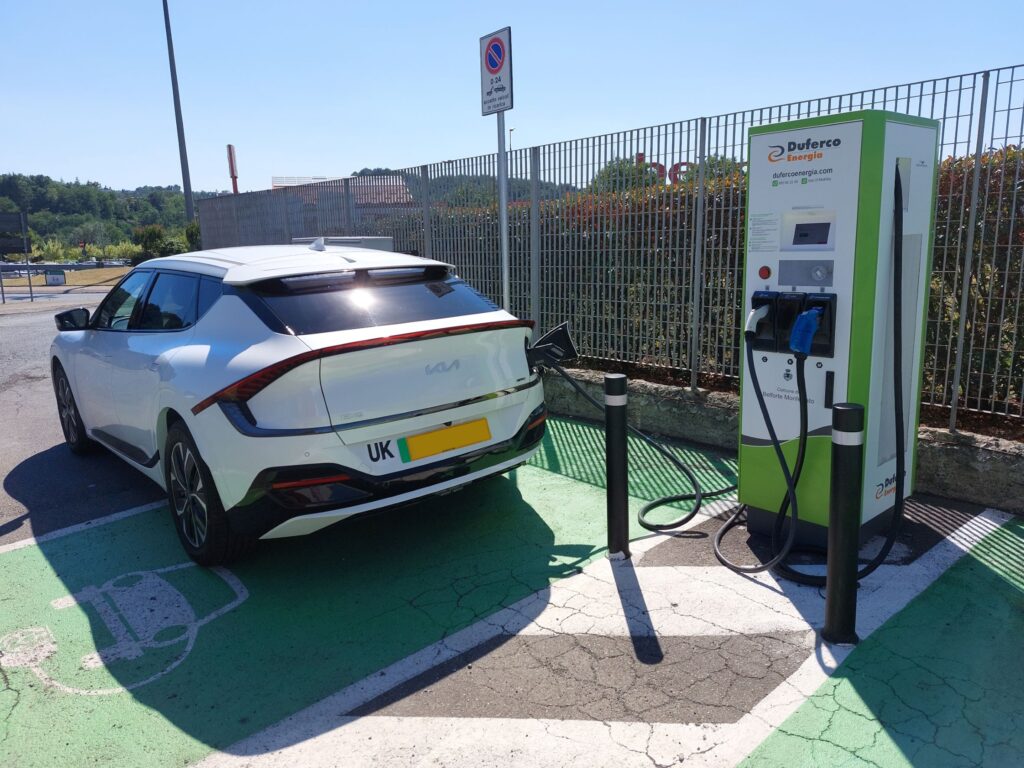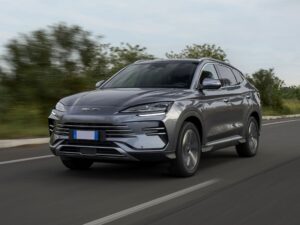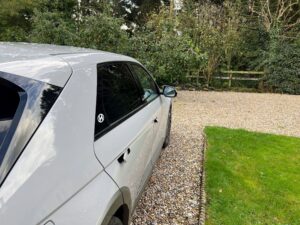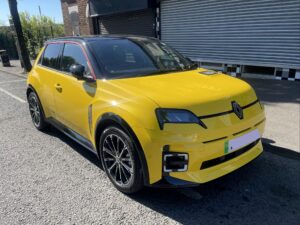Martin J drove from Yorkshire to Elba (an island in Tuscany, Italy) in his Kia EV6 GT Line 77.4kWh AWD electric car.
Introducing your road trip
For our first holiday since the pandemic started, we decided back in April to drive to Elba in our 6-month old EV6 in late June/early July. We wanted to avoid the stress and Covid risks of airports and queues and reconnect with Europe at ground level. Until this point, the longest trip we’d done in the EV6 was around 500 miles in the UK.
Our route from Yorkshire took us to Harwich (via Gridserve’s terrific new Electric Forecourt at Braintree), via the overnight ferry from Harwich to Hoek van Holland, and thence through the Netherlands, Germany (A61/A5), Switzerland (the San Gottardo route) and down through Italy to Piombino, where we took the one hour ferry trip to Elba, a chunk of Tuscany adrift in the Tyrrhenian Sea.
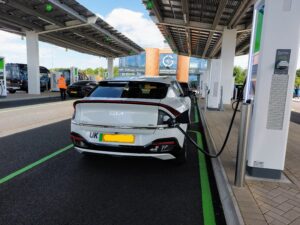
We took overnight stops in Karlsruhe, Turate (near Milan) and Pisa. After a week’s stay on the island, we retraced our route north through Italy, with a diversion through the Valle d’Aosta and the San Bernardo tunnel into western Switzerland, rejoining the outbound route near Basel, with three overnight stops (near Alessandria, Bern and Koblenz).
The total distance travelled was 2,440 miles.
Sign-up to Electric Road now to receive a FREE ‘Guide to the Best Electric Cars’, a weekly Newsletter and to win some great prizes!
Planning & preparation
I used ABRP (A Better Route Planner) to start planning the route and charging stops, supplementing this with more detailed route planning using Google Maps. Using ABRP I was able to enter important parameters such as vehicle specification and load, minimum state of charge (SoC) at start and arrival and minimum SoC desired on arrival at charging stations.
Most importantly, I was able to express a preference for specific charging networks (in my case, IONITY, to take advantage both of the EV6’s 240kW charging capability and Kia Charge’s discount on IONITY charging). The ABRP solution used only IONITY chargers except in Italy, where they’re thinner on the ground. Here, one stop at an Enel-X charger was recommended. I downloaded the Enel-X JuicePass app to be on the safe side, even though Kia Charge includes Enel-X. This proved to be a wise precaution.
Another important source of information was Italian YouTube videos and the Italian forum forumelettrico.it, through which we discovered a new charger near one of our overnight stops which eliminated the need for one of the ABRP charging stops. As things panned out, we diverted from the ABRP plan on a couple of other occasions, as explained below.
And I also found recent road trip experience from other EV owners useful, notably a recent trip to Italy reported by Andrew Till (@tillathenun).
It’s axiomatic among EV drivers that you need a Plan B, C and D when undertaking a long trip. But we didn’t develop these ahead of time and we didn’t need them. One reason was that the ABRP solution proved conservative, so at any point we had enough range left to skip an entire stop without deviating from the route (and a couple of times we opted to do this from choice, once our confidence levels grew). Another, especially relevant for Germany, was that the provision of ultra-rapids at autobahn service areas is so good that alternative stops were always a possibility.
Charging your EV6
To start with how long charging took, it’s tempting to be provocative and say it took NO TIME AT ALL, because almost every charging session coincided with a coffee/loo/lunch stop we’d have made anyway even if driving a petrol car. This is 95% true: typically, we were adding between 20 and 50 kWh at each session, which at IONITY chargers took between 10 and 20 minutes. But we did waste time on two occasions, once (and the only time this happened) when an IONITY charge failed and we needed a Plan B and once when an Enel-X charger in Italy proved to be ‘fuori servizio’, despite showing as available on the Kia Charge app.
In total we used 22 charging sessions. The provider breakdown:
- IONITY 12
- EnBW 3
- Gridserve 2
- and EnelX, BeCharge, DuFerco, Fastned and GoElectric 1 each.
Number of times we had to queue for a charger: ZERO. Yes, really, but perhaps we were lucky.
- Day 1 charging stops were at IONITY Cambridge (not recommended: the bays were too small for the EV6 and the adjacent BMW iX, with very little manoeuvring space) and Gridserve Braintree (brilliant: the future of EV charging)
- Day 2: a straightforward IONITY charge at Sevenum and then at Brohtal an IONITY failure: the car connected but the charger stopped the charge immediately. The same happened at all the vacant chargers on the site. The first moment of anxiety: had my Kia RFID card stopped working? What if this happened at all the remaining chargers? We had enough range to reach the next planned IONITY stop at Bruchsal but instead decided to try the next service area at Moseltal, where the Kia app showed an EnBW charger. This worked perfectly: at 30 degrees, the EV6 pulled 233kW and we were soon on our way. That was the only charger anxiety of the entire trip.
- Roadworks at Bruchsal prompted us to use another EnBW 300kW hypercharger at a shopping centre near our hotel in Karlsruhe.
- IONITY charges at St Gotthard services in Switzerland, Binasco near Milan, and Versilia near Viareggio were uneventful.
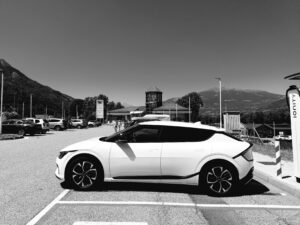
- With time to kill before the ferry to Elba (and mindful of the lack of anything faster than 11kW on the island), we tried to top up at a 50kW Enel-X charger in San Vincenzo but found it out of order. A nearby 22kW Enel-X charger gave us 10kW while we had a coffee. In the event both were unnecessary: we used one of the 22kW BeCharge chargers near our hotel on Elba to put the car on 100%. This network would not accept the Kia card but it was simple to start a charge using the Enel-X JuicePass app.
- The return journey was entirely uneventful. A 50kW DuFerco charger near our hotel in Piemonte (thanks forumelettrico.it) worked perfectly and saved us a stop the next morning at one of the new Free-to-X chargers on the A26 autostrada.
Charging hints from this trip? Use Google to locate the charging posts as precisely as you can within motorway service areas ahead of time. They’re often not included in the directional signage when you enter the service area and if you overshoot them the one-way traffic flows can make it hard to get back to them. At Sandelingen Oost near Rotterdam, on the return trip, there are three different sets of ultra rapids.
Failing to spot the IONITY posts located at the very far end of the large service area, we settled for a Fastned charge at twice the price. And you can change the language on the charger displays. I didn’t notice this at first so my vocabulary has improved significantly (by the way the IONITY panels are very hard to read in strong sunlight).
What did it cost? I haven’t yet had the bill for the return leg but the outbound leg cost £115 (it would have been closer to £90 using IONITY instead of EnBW chargers), so roughly £220 overall including charging back up at home).
Did you encounter any great driving roads on your road trip? If so, where were they and why were they great?
The route from Ivrea north to Aosta on the A5 is spectacular as the wall of the Alps approaches and the SS27 from Aosta to the San Bernardo tunnel is excellent: sweeping bends and great views. The last time I came this way, a petrol engine was labouring under the bonnet; carving up the mountainside in eery near-silence was a new EV experience.
The EV6
The EV6 was perfect for this trip, although the Alpine scenery made me briefly wish for a panoramic roof (I’m not normally a fan of these).
Some key points:
Performance – we know that most EVs can out-accelerate the hot hatchback of your choice away from the lights but the AWD EV6 impressed with its huge acceleration from 80km/h to 150km/h. This was invaluable on unrestricted two-lane sections of German autobahns, where the speed differential of the two lanes can be huge and careful timing for overtakes is needed. In Italy, mad tailgating Audis and Alfas could easily be left behind once slower traffic cleared.
Economy – once charger anxiety disappeared, I started to use the performance more freely than I would in the UK, with some sustained 130 to 140km/h cruising where permitted. Despite this, overall economy for the trip was 3.7 mi/kWh, which seems pretty good for a big car with three adults and luggage.
Practicality – the EV6 has been criticised for its relatively modest boot space but it swallowed a wheelchair and luggage for three, with a couple of soft bags inside the car. Seat comfort was terrific, with no aches or numbness after a hard day’s drive.
Charging – the 800V architecture the EV6 shares with the IONIQ 5 and GV60 really came into its own on a long trip. The car was ready to set off after a charging stop before we were, a peaceful cappuccino often interrupted by a notification from the car that it was fully charged (I set a 90% charge limit on the ultra rapids).
Driving aids – the Kia Highway Driving Assist (HDA) is good but I rarely used it, simply because I prefer to do it myself. The inbuilt sat nav, however, is not so good. Vocal instructions were sometimes late or ambiguous, the map was hard to read in sunlight and the system’s pronunciation of place names was atrocious, occasionally so bad as to make them unrecognisable. I was glad of a co-driver with a road atlas and although I’ve never bothered with smartphone mirroring, I’m considering using Android Auto when I need sat nav. But it’s a small irritation in a terrific EV.
Road trip conclusion
This trip to Elba was a huge success. It’s built my EV confidence enormously and I wouldn’t hesitate to undertake another transcontinental trip (in fact we’re already contemplating one). The EV6’s charging speed (almost more important than its range) its autobahn-monstering performance and refinement were important factors. We may have been unusually fortunate not to have encountered any queues (on one IONITY occasion in Germany a small queue built up after we’d arrived but it turned over very quickly). ABRP was an invaluable planning tool and the Kia Charge RFID card worked perfectly. Another key factor was the availability of ultra rapids on motorway service areas, the UK has a lot of catching up to do here.
See other road trip reports here

